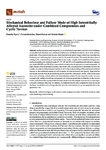Mechanical behavior and failure mode of high interstitially Alloyed Austenite under combined compression and cyclic torsion

View/
Date
2022-01Author
Ngeru, Timothy
Kurtulan, Dzhem
Karkar, Ahmet
Hanke, Stefanie
Metadata
Show full item recordAbstract
multiaxial stress states frequently occur in technical components and, due to the multitude
of possible load situations and variations in behaviour of different materials, are to date not fully
predictable. This is particularly the case when loads lie in the plastic range, when strain accumulation,
hardening and softening play a decisive role for the material reaction. This study therefore aims at
adding to the understanding of material behaviour under complex load conditions. Fatigue tests
conducted under cyclic torsional angles (5°, 7.5°, 10° and 15°), with superimposed axial static compression loads (250 MPa and 350 MPa), were carried out using smooth specimens at room temperature. A
high nitrogen alloyed austenitic stainless steel (nickel free), was employed to determine not only the
number of cycles to failure but particularly to aid in the understanding of the mechanical material
reaction to the multiaxial stresses as well as modes of crack formation and growth. Experimental
test results indicate that strain hardening occurs under the compressive strain, while at the same
time cyclic softening is observable in the torsional shear stresses. Furthermore, the cracks’ nature is
unusual with multiple branching and presence of cracks perpendicular in direction to the surface
cracks, indicative of the varying multiaxial stress states across the samples’ cross section as cross slip is
activated in different directions. In addition, it is believed that the static compressive stress facilitated
the Stage I (mode II) crack to change direction from the axial direction to a plane perpendicular to the
specimen’s axis.
